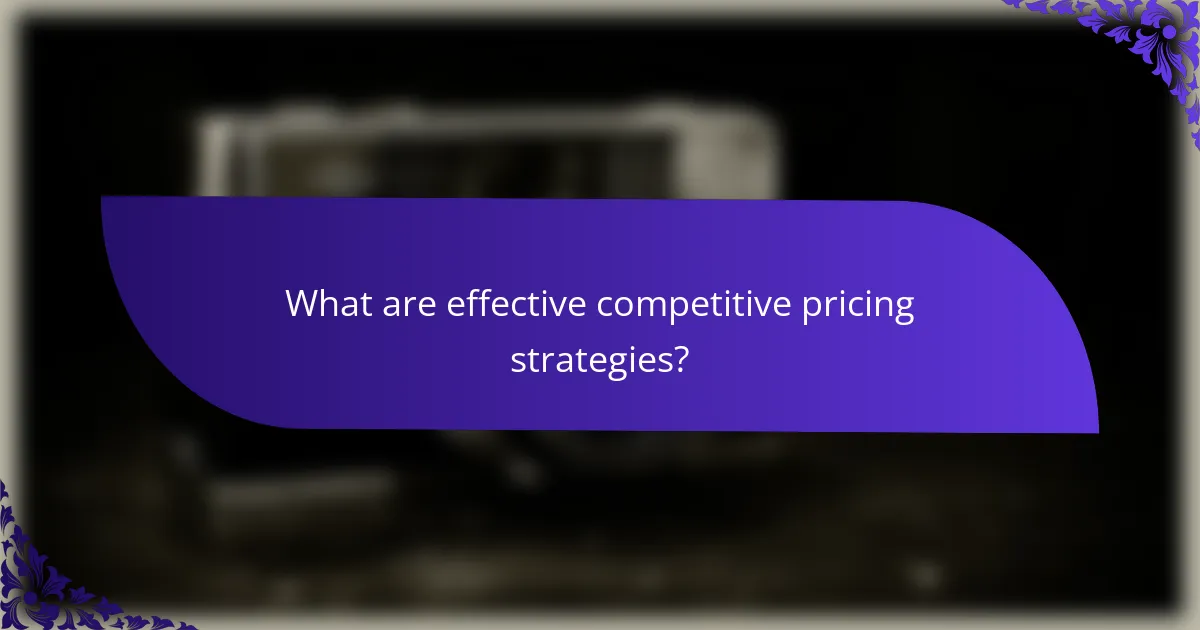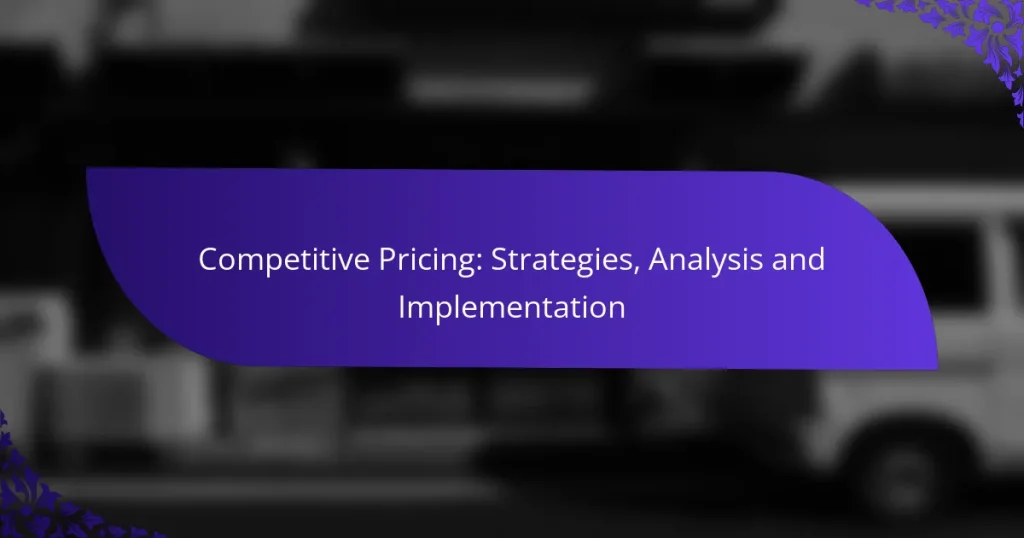Competitive pricing is a strategic approach that focuses on setting prices based on competitors’ offerings, market demand, and perceived value to attract customers while ensuring profitability. Analyzing competitors’ pricing structures and promotional strategies is crucial for identifying trends that can inform your own pricing decisions. Successful implementation requires a systematic process of defining objectives, collecting data, and continuously adjusting prices to align with market conditions and customer expectations.

What are effective competitive pricing strategies?
Effective competitive pricing strategies involve setting prices based on competitors’ pricing, market demand, and perceived value. These strategies help businesses attract customers while maintaining profitability and market share.
Value-based pricing
Value-based pricing focuses on setting prices based on the perceived value to the customer rather than the cost of production. This strategy requires understanding customer needs and how much they are willing to pay for specific benefits. For example, luxury brands often use this approach to justify higher prices through perceived quality and exclusivity.
To implement value-based pricing, conduct market research to gauge customer perceptions and preferences. Avoid underpricing, as it may undermine the perceived value of your product or service.
Dynamic pricing
Dynamic pricing adjusts prices in real-time based on market demand, competition, and other external factors. This strategy is commonly used in industries like travel and hospitality, where prices fluctuate based on availability and demand. For instance, airlines often increase ticket prices as the departure date approaches.
When using dynamic pricing, ensure transparency to maintain customer trust. Automated pricing tools can help manage changes effectively, but be cautious of potential backlash from customers who may feel manipulated.
Penetration pricing
Penetration pricing involves setting a low initial price to attract customers and gain market share quickly. This strategy is effective for new products entering a competitive market. For example, a new streaming service might offer a low subscription fee to entice users away from established competitors.
While penetration pricing can boost initial sales, consider the long-term implications on profitability. Gradually increasing prices after establishing a customer base can help transition to sustainable pricing.
Price skimming
Price skimming sets a high initial price for a new product, targeting customers willing to pay more before gradually lowering the price. This strategy is often used for innovative products, such as electronics, where early adopters are less price-sensitive. For instance, a new smartphone might launch at a premium price before discounts are offered later.
To effectively use price skimming, ensure that the product offers unique features that justify the high price. Monitor competitor reactions and market trends to adjust pricing strategies as needed.
Psychological pricing
Psychological pricing leverages consumer behavior by setting prices that have a psychological impact, such as pricing a product at $9.99 instead of $10. This strategy can make products appear more affordable and encourage purchases. Retailers frequently use this technique to influence buyer decisions.
When implementing psychological pricing, consider the target audience’s perception and cultural factors that may affect price sensitivity. Avoid overusing this tactic, as it can lead to customer skepticism if prices seem artificially low.

How to analyze competitors’ pricing?
To analyze competitors’ pricing effectively, gather data on their pricing structures, promotional strategies, and market positioning. This involves understanding how your competitors set their prices and identifying any trends or patterns that could inform your own pricing strategy.
Market research techniques
Market research techniques include surveys, focus groups, and competitor analysis. Surveys can help gauge customer perceptions of pricing, while focus groups provide qualitative insights into consumer preferences. Additionally, analyzing competitors’ websites and marketing materials can reveal their pricing strategies and promotional tactics.
Consider using online tools to track competitor pricing over time. This can help identify trends and shifts in the market, allowing you to adjust your pricing strategy accordingly. Regularly reviewing competitor offerings can also highlight gaps in your own pricing model.
SWOT analysis
Conducting a SWOT analysis (Strengths, Weaknesses, Opportunities, Threats) can provide a comprehensive view of your pricing strategy in relation to competitors. Identify your strengths, such as unique product features or superior customer service, which can justify higher prices. Conversely, recognize weaknesses that may require more competitive pricing.
Opportunities may include gaps in the market where competitors are underpricing or overpricing. Threats could involve new entrants or changes in consumer behavior that impact pricing dynamics. Regularly updating your SWOT analysis ensures that your pricing remains competitive and aligned with market conditions.
Price comparison tools
Price comparison tools can streamline the process of analyzing competitors’ pricing. These tools aggregate pricing data from various sources, allowing you to see how your prices stack up against competitors in real time. Popular options include websites and apps that provide side-by-side comparisons of similar products.
When using price comparison tools, ensure they are up-to-date and cover the relevant market segments. Keep in mind that while these tools can provide valuable insights, they should be used alongside other research methods for a comprehensive understanding of the competitive landscape.

What are the steps to implement competitive pricing?
Implementing competitive pricing involves a systematic approach that includes defining objectives, gathering competitor data, setting a pricing structure, and continuously monitoring and adjusting prices. These steps ensure that your pricing strategy aligns with market conditions and customer expectations.
Define pricing objectives
Establishing clear pricing objectives is crucial for effective competitive pricing. Common objectives include maximizing profit margins, increasing market share, or enhancing customer loyalty. Each goal will influence your pricing strategy differently, so it’s essential to prioritize based on your business needs.
For example, if your aim is to capture market share, you may consider setting lower prices than competitors. Conversely, if maximizing profits is the goal, you might opt for premium pricing strategies that reflect higher value.
Gather competitor data
Collecting data on competitors is vital for understanding the pricing landscape. This includes analyzing their pricing models, promotional strategies, and customer reviews. Tools like price comparison websites or market research reports can provide valuable insights.
Consider creating a competitor pricing matrix to visualize how your prices stack up against others in your industry. This can help identify gaps in your pricing strategy and opportunities for adjustment.
Set pricing structure
Once you have defined your objectives and gathered competitor data, the next step is to establish your pricing structure. This may involve choosing between cost-plus pricing, value-based pricing, or dynamic pricing strategies. Each method has its advantages and can be tailored to fit your business model.
For instance, a cost-plus approach works well for manufacturers who need to cover production costs, while value-based pricing is more suitable for service-oriented businesses that offer unique benefits. Ensure that your pricing structure aligns with your overall objectives and market positioning.
Monitor and adjust pricing
After implementing your pricing strategy, continuous monitoring is essential to ensure its effectiveness. Regularly review sales data, customer feedback, and competitor pricing changes. This will help you identify trends and make informed adjustments as needed.
Be prepared to adjust your prices in response to market fluctuations, seasonal demand, or changes in competitor strategies. Establish a schedule for reviewing your pricing strategy, such as quarterly or bi-annually, to maintain competitiveness and profitability.

What criteria should be considered for pricing decisions?
Pricing decisions should consider market demand, cost structure, and customer segmentation. These criteria help businesses establish competitive prices that align with their financial goals and market positioning.
Market demand
Understanding market demand is crucial for setting prices that attract customers while maximizing revenue. Analyze trends, customer preferences, and economic conditions to gauge how much consumers are willing to pay. For instance, during a product launch, prices may be set higher to capture early adopters, while discounts can be offered later to stimulate sales.
Utilizing tools like surveys or market research can provide insights into demand elasticity, helping to determine how price changes might affect sales volume. Keep in mind that demand can fluctuate seasonally, so adjust pricing strategies accordingly.
Cost structure
Your cost structure directly impacts pricing decisions. Calculate both fixed and variable costs to understand the minimum price needed to maintain profitability. Fixed costs include rent and salaries, while variable costs might involve materials and shipping.
Establish a pricing model that covers costs while remaining competitive. For example, if your total costs are 50 BGN per unit, consider setting a price that is at least 20-30% higher to ensure a healthy profit margin. Regularly review costs to adapt pricing strategies as necessary.
Customer segmentation
Customer segmentation allows businesses to tailor pricing strategies to different groups based on their willingness to pay. Identify segments such as budget-conscious consumers, premium buyers, or niche markets, and adjust pricing accordingly. For instance, offering discounts to students or loyalty programs for frequent buyers can enhance customer retention.
Utilize data analytics to refine your understanding of customer behaviors and preferences. This targeted approach can lead to more effective pricing strategies, ensuring that each segment is served appropriately without alienating others. Be cautious of over-segmentation, which can complicate pricing structures and confuse customers.


